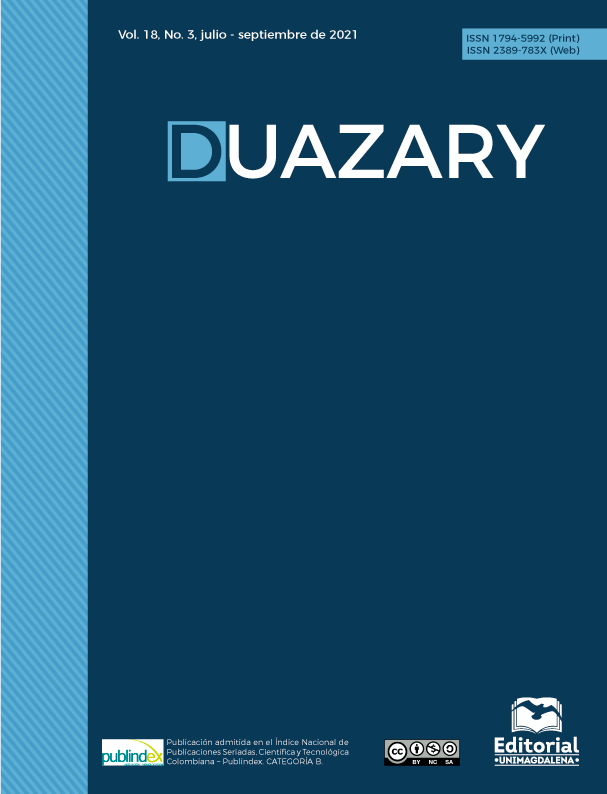Trombosis bilateral del seno cavernoso en un paciente con enfermedad periodontal y diabetes mellitus. descripción de un caso
Contenido principal del artículo
Resumen
La trombosis de los senos cavernosos (TSC) corresponde a una entidad vascular poco usual, asociada con alta morbimortalidad y secuelas neurológicas. La etiología más frecuente son los procesos infecciosos a nivel de cabeza y cuello, que sirven como puerta de entrada para diferentes microorganismos, generando una respuesta inflamatoria que desencadena el evento trombótico. La enfermedad periodontal caracterizada por inflamación gingival, pérdida de tejido conectivo circundante y eventual del diente está asociada con el desarrollo de enfermedades sistémicas secundarias a los patógenos periodontales y mediadores inflamatorios producidos en la cavidad oral. Estos pueden diseminarse y producir complicaciones por contigüidad como eventos trombóticos a nivel del sistema nervioso central. A continuación, se presenta el caso clínico de un paciente que desarrolló una TSC bilateral después de ser sometido a un procedimiento periodontal.
Descargas
Detalles del artículo

Esta obra está bajo una licencia internacional Creative Commons Atribución-NoComercial-CompartirIgual 4.0.
No se permite un uso comercial de la obra original ni de las posibles obras derivadas, la distribución de las cuales se debe hacer con una licencia igual a la que regula la obra original.
Citas
Dinkin M, Patsalides A, Ertel M. Diagnosis and Management of Cerebral Venous Diseases in Neuro-Ophthalmology: Ongoing Controversies. Asia-Pacific Journal of Ophthalmology. 2019; 8(1): 73-85. Doi: http://dx.doi.org/10.22608/APO.2018239
Cho JY, Kim HM, Ryu JY. Cavernous sinus thrombosis progression from trismus. Journal of the Korean Association Oral and Maxillofacial Surgeons. 2015; 41(1): 43-7. Doi: http://dx.doi.org/10.5125/jkaoms.2015.41.1.43
Guenther G, Arauz A. Trombosis venosa cerebral: aspectos actuales del diagnóstico y tratamiento. Neurología. 2011; 26(8): 488-98. Doi: http://dx.doi.org/10.1016/j.nrl.2010.09.013
Khatri IA, Wasay M. Septic cerebral venous sinus thrombosis. Journal of the Neurological Sciences. 2016; 362: 221-7. Doi: http://dx.doi.org/10.1016/j.jns.2016.01.035
Desa V, Green R. Cavernous Sinus Thrombosis: Current Therapy. Journal of Oral and Maxillofacial Surgery. 2012; 70(9): 2085-91. Doi: http://dx.doi.org/10.1016/j.joms.2011.09.048
Hsu CW, Tsai WC, Lien CY, Lee JJ, Chang WN. The clinical characteristics, implicated pathogens and therapeutic outcomes of culture-proven septic cavernous sinus thrombosis. Journal of Clinical Neuroscience. 2019; 68: 111-6. Doi: http://dx.doi.org/10.1016/j.jocn.2019.07.022
Bhatia H, Kaur R, Bedi R. MR imaging of cavernous sinus thrombosis. European Journal of Radiology Open. 2020; (7): 100226. Doi: http://dx.doi.org/10.1016/j.ejro.2020.100226
Bui FQ, Coutinho CL, Huynh B, Trinh A, Liu J, Woodward J, et al. Association between periodontal pathogens and systemic disease. Biomedical Journal. 2018; 42(1): 27-35. Doi: http://dx.doi.org/10.1016/j.bj.2018.12.001
Mahalingam HV, Mani S, Patel B, Prabhu K, Alexander M, Fatterpekar G, et al. Imaging Spectrum of Cavernous Sinus Lesions with Histopathologic Correlation. Radiographics. 2019; 39(3): 795-819. Doi: http://dx.doi.org/10.1148/rg.2019180122
Gallagher JP. Septic thrombosis of the cavernous sinus. The Medical Annals of the District of Columbia. 1960; 29: 278-83. Available at: https://pubmed.ncbi.nlm.nih.gov/13826082/
Hsu YJ, Lin KD, Chen JH, Lee MY, Lin YC, Yen FC, et al. Periodontal Treatment Experience Associated with Oral Health-Related Quality of Life in Patients with Poor Glycemic Control in Type 2 Diabetes: A Case-Control Study. International Journal of Environmental Research ans Public Health. 2019; 16(20): 4011. Doi: http://dx.doi.org/10.3390/ijerph16204011
Rohani B. Oral manifestation in patients with diabetes mellitus. World Journal of Diabetes. 2019; 10(9): 485-9. Doi: http://dx.doi.org/10.4239/wjd.v10.i9.485
Colbert S, Cameron M, Williams J. Septic thrombosis of the cavernous sinus and dental infection. British Journal of Oral and Maxillofacial Surgery. 2011; 49(6): e25-e26. Doi: http://dx.doi.org/10.1016/j.bjoms.2010.07.004
Critchley JA, Carey IN, Harris T, Dewilde S, Hosking D, Cook D, et al. Glycemic Control and Risk of Infections Among People With Type 1 or Type 2 Diabetes in a Large Primary Care Cohort Study. Diabetes Care. 2018; 41(10): 2127-35. Doi: http://dx.doi.org/10.2337/dc18-0287
Rajagopalan S. Serious Infections in Elderly Patients with Diabetes Mellitus. Clinical Infectious Diseases. 2005; 40(7): 990-6. Doi: http://dx.doi.org/10.1086/427690
Bhatia K, Jones NS. Septic cavernous sinus thrombosis secondary to sinusitis : are anticoagulants indicated ? A review of the literature. The Journal of Laryngology and Otology. 2017; 116(9): 667-76. Doi: http://dx.doi.org/10.1258/002221502760237920
Xu W, Gao L, Li T, Shao A, Zhang J. Efficacy and risks of anticoagulation for cerebral venous thrombosis. Medicine Baltimore. 2018; 97(20): e10506. Doi: http://dx.doi.org/10.1097/MD.0000000000010506
Coutinho J, de Bruijn SF, Deveber G, Stam J. Anticoagulation for cerebral venous sinus thrombosis. The Cochrane Database of Systematic Reviews. 2011; 2011(8): CD002005. Doi: http://dx.doi.org/10.1002/14651858.cd002005.pub2

